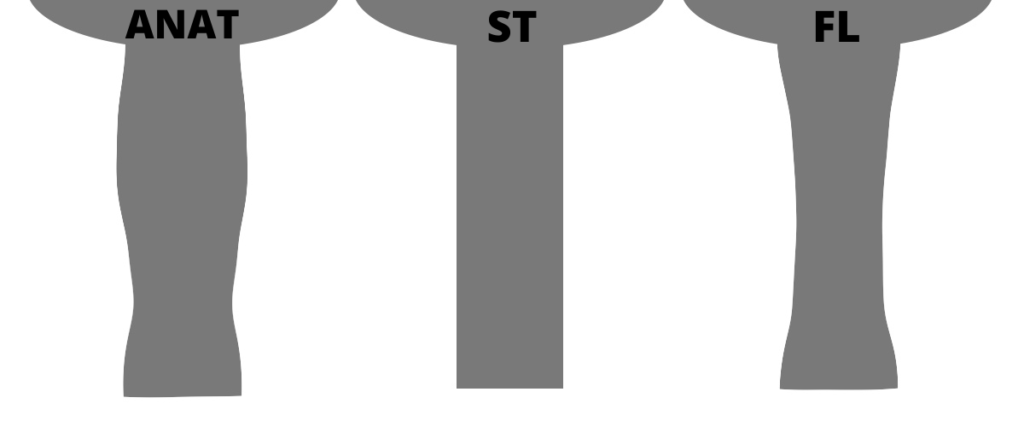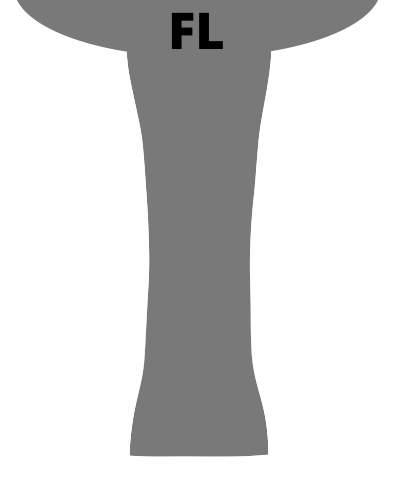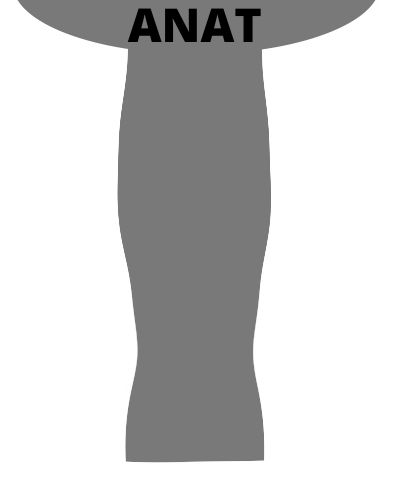Choosing the right type of handle is an important decision when purchasing a table tennis blade or paddle. In this article, I’ll explain the advantages and disadvantages of the three main table tennis paddle handles so you can decide which one is the most suitable for you.
Types of Blade Handles
There are three main types of table tennis blade handles: flared (FL), straight (ST) and anatomic (ANAT). The flared handle works best for forehand dominant players, whilst the straight handle is best for balanced players. Anatomic handles suit players who hit the ball very hard instead of using spin.
These types of handles are used for shakehand grips primarily. Here is an article comparing the differences between shakehand and penhold grips if you are unsure which to use.

Flared (FL)
The flared (FL) blade handle-type is the most popular in Chinese. It is easy to hold loosely without dropping the paddle and is very good for forehand dominant players. The main issue with the flared handle is that it can make it hard to transition to the backhand side quickly.

Advantages
- The flared handle is the easiest to hold without dropping the paddle. Since the blade handle is wider at the bottom, it keeps it from slipping out of the player’s hand and gives them more confidence to play powerful shots.
- For forehand dominant players, the flared handle type is usually the most suitable as it makes it easy to adjust the paddle to different forehand angles.
Disadvantages
- The flared nature of this handle makes transitioning from the forehand to the backhand more difficult than other types as it can feel slightly awkward when rotating the paddle.
- Many flared handles are quite slim, which can make it more difficult for players with larger hands.
Who is the flared handle good for?
- Forehand dominant players
- Players who use looping frequently
- Players who stand mid-distance from the table
Straight (ST)
The straight (ST) blade handle-type the most popular choice in Europe as it makes forehand to backhand transitions easy, making it suitable for players who have a fairly balanced forehand and backhand. The main issue with the straight handle is that it needs to be held reasonably tightly to avoid dropping the paddle.

Advantages
- Straight-type handles are usually wider than flared handles so generally suit players with larger hands more.
- Straight handles usually make the paddle feel more balanced as the center of mass is central on the handle.
- This is a very good handle type for switching from forehand to backhand. Since the handle is the same width at every point, there is no awkward shape to contend with when moving your wrist.
- The straight handle is good for backhand dominant players because you have a more flexible wrist action.
Disadvantages
- The straight handle needs to be gripped more tightly to avoid dropping it. This can cause some players to feel more tense which isn’t a good thing. In order to get the most out of your strokes, you ideally need to be as relaxed as possible.
- The extra width of the straight-handle compared to other types can make it less suitable for players with smaller hands.
Who is the straight handle good for?
- Players who switch between backhand and forehand frequently
- Backhand-dominant players
- Players who stand close to the table
Anatomic (ANAT)
The anatomic handle is a less-popular blade handle-type because it is not a very good option for players who stand farther back from the table or for looping shots. However, the anatomical handle is good for flat strokes so is suitable for certain types of players.
It can be hard to identify the difference between an anatomic and flared handle at first glance, however they are quite different. The anatomic handle has a “wave-shape” which means it’s wider in the middle and at the end, and narrower at the top and just before the point where it flares out.

Advantages
- The anatomic handle is good for players who hit the ball very hard as it has a stable feeling.
- It’s hard to drop since it flares out at the bottom, meaning you don’t have to grip it as tightly compared to the straight-handle.
Disadvantages
- It can be hard to find blades with anatomic handles as most brands tend to make more flared and straight-type handles.
- The anatomic handle restricts wrist movement which can make it hard to transition between the forehand and backhand.
- The unique shape only suits certain grip positions and hand sizes, so some players may find it quite uncomfortable.
- Can be more difficult to apply spin to the ball as it needs to be gripped in a specific position.
Who is the anatomic handle good for?
- Players who use the hitting-style
- Players who prefer to use power instead of spin
- Players who stand far away from the table
Which Blade Handle is the Best?
The “best” handle type is different for different players because each handle has it’s own pros and cons.
However, I appreciate that’s not super helpful for beginners who are just looking to purchase their first blade, or players who are looking more closely at their equipment to see if making changes will improve their performance, so here are some more definitive points to round up this article with.
- The flare (FL) blade handle is the best option for forehand dominant players who like to grip the paddle quite loosely.
- The straight (ST) blade handle is the best option for backhand dominant players, or those who have a more balanced forehand and backhand.
- The anatomic (ANAT) handle is good for players who prioritise power over spin. It’s generally not used by beginners and usually is quite polarising, some players swear by it and others find it very uncomfortable.
If you’re a complete beginner then the best handle to start with is the straight handle. It makes it easier to transition from forehand to backhand than the flare blade handle, and it is generally considered comfortable by most players.
